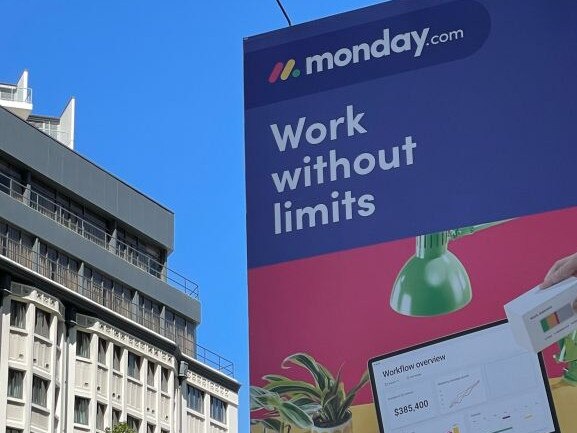How Monday.com cracked the B2B barrier
With clients such as Aesop, Tennis Australia and Uber, software firm Monday.com is ramping up locally.

The need for greater transparency in workforces during turbulent lockdown times, combined with a data-driven mission and a measured advertising rollout are all helping business to business (B2B) giant Monday.com grow to new heights.
With Covid sparking so much business change, workers and firms needed a simple, clean view of everything going on, according to Gavin Watson, industry lead, marketing, creative and advertising at Monday.com in APAC.
“The pandemic has been a catalyst for a lot of change, and from a marketer's perspective the thing most of us needed was visibility,” he said.
“It wasn’t just about what is going on with me and what I'm doing, but broader across the team and organisation.”
Mr Watson said the 2012 Tel Aviv-founded project management software business, which launched in Australia early 2020 before listing on the Nasdaq in July 2021, believed that transparency and being data-driven was more important than ever as brands, agencies and marketing departments continued to re-emerge from the pandemic.
“This level of transparency is what enabled us to grow and navigate the turbulent lockdown period, so it’s absolutely an important aspect to what is ahead for the brand as well,” he said.
The Melbourne-based exec, who argues that being more data-driven can help marketers earn buy-in from leadership to experiment and test new, innovative strategies for increasing brand awareness and return on investment, says the role of data is also important in harnessing creativity.
With remote working, keeping track of employees’ stamina, wellbeing and morale is one of the biggest challenges. Recent research conducted on 7000 professionals showed marketing and communications professionals were faring the worst with the highest burnout.

Mr Watson, who works cross departmentally to help spearhead marketing, creative and advertising said sporadic Zoom check-ins with employees often didn’t paint the full picture of how employees were coping.
“There is now an urgent need to create space for creativity within the marketing industry,” Mr Watson explained.
“Having visibility into productivity levels can often indicate when people are feeling burnt out and when shifts need to be made to make more space for creativity within marketing.”
Mr Watson said marketing and creative teams typically used Monday.com software to manage marketing and creative processes in one place, project managers used it to manage and track projects and portfolios, while sales teams tended to lean into its customer relationship management (CRM) tool to manage the sales cycle.
Clients such as Aesop, Canva, Destination NSW, Hulu, RMIT Online, Sydney Opera House, Taronga Zoo, Tennis Australia and Uber are among Monday.com’s more than 11,000 paying customers in Australia.
From graphic designers, motion designers and producers to campaign managers, creative managers and content writers, Monday.com has more than 100 marketing professionals globally to produce its ads and campaigns.
In global campaigns it collaborates with local agencies on the ground that are familiar with the culture and marketing trends in each country, but as the local team swells beyond 80 in Australia, with offices in Sydney and Melbourne, its own marketing function is set to expand.
In May, Monday.com debuted its first Super Bowl commercial, Work Without Limits, which despite being in the US and typically more of an advertising tactic made by major business to consumer (B2C) brands such as Budweiser, Samsung, and Taco Bell, Mr Watson said the move had positive repercussions Down Under.
In Australia the Monday.com team shared the Super Bowl ad and behind the scenes videos across social channels locally.
“By turning it into social content and sharing across our channels we actually got a lot of inquiries and interest on the ground,” Mr Watson said.
The Big Game ad showed workers defying gravity to burst through not just the office ceiling, but the roof of the building, as well as presentations coming to life as a drones emerged from a whiteboard and flew into the office.
Mr Watson said whether it was reaching audiences through B2B or B2C strategies, engagement “has to be emotive”.
“Since day one of our marketing efforts, our strategy has been to do B2C marketing in a B2B realm, and it’s working for us,” he said.
“Oftentimes B2C is more associated with emotions as it is much easier as humans to connect to a commodity than to software, but we try to break this paradigm ourselves as a brand.”
Monday.com, which also partnered with Vogue for the Met Gala’s first branded content software partnerships this year, saw its first-quarter revenue surpass $US100m ($144m), growing 84 per cent year over year.
In a sign the business plans to increase its presence in the Australian market, in March it launched an out of home (OOH) campaign to increase brand awareness in Australia. With a focus in Sydney and Melbourne a series of brightly coloured billboards were rolled out to reach its audience while they were in a work mindset while commuting .
Mr Watson said the business experienced a 40 per cent increase in site visits on average during the time of the campaign and around 20 per cent in the 30 days after it ended.
He said while he believed OOH was not a standalone channel, as it aligned its messaging with other channels to enhance its impact, such as online campaigns and B2B marketing and events, the brand globally rated the ad tactic highly.
“We believe in out of home as a great brand awareness channel as we have a lot of experience with it around the world,” he said.
“We have our own internal objectives and key results tracked and for OOH we see a lot of success by reaching our business and growth goals through this channel.”
On weighing up new marketing tactics and potential media or sponsorship partnerships, Mr Watson said the company was reviewing where more of its ad dollars would go.
“From a branding perspective there’s lots we would love to do, but every dollar we spend we have got to be able to measure it,” he said. “If we're not seeing the results, you don’t continue to do it or move elsewhere.”
Adding that he’s worked in other companies where marketing has not been looked at this way, he believes for Monday.com that’s been a large part of its success.




To join the conversation, please log in. Don't have an account? Register
Join the conversation, you are commenting as Logout